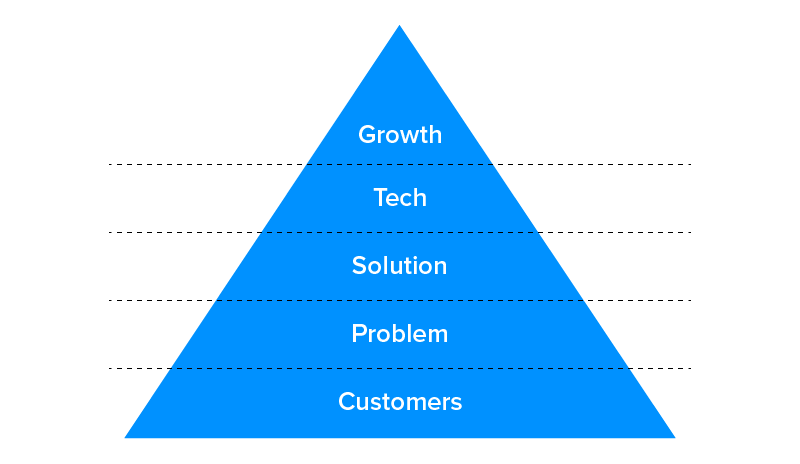An Entrepreneur’s Guide to Successfully Pivot Your Startup
Slack was not always the messaging platform that we have grown to love and use. The platform, compared to what it is now was born as a very small feature of a Tiny Speck game called Glitch.
After seeing the success and demand for the in-built messaging feature, the founders chose to launch it as a brand new application, while bidding adieu to Glitch.
This route which they took was an example of a lean methodology concept that we call startup pivot. Let’s get you some perspective into what is a pivot in a business model, why should startups consider it, and the best growth hacking strategies for startups to go about pivot business model.
Table Of Content
- What Is A Pivot in Business?
- Know When Should You Pivot In Startup
- What are the Different Types of Pivots?
- How To Startup Pivoting: The best strategies
- Successful Tech Pivot in Business Stories
- Pivot Startup Pyramid: How We Help Founders Make Changes In Different Business Areas
- What are the Alternatives to Business Pivot
What Is A Pivot in Business?
A pivot is primarily a shift in the business strategy which is applied for testing out a new approach related to the startup business model after receiving feedback. It is one of the core concepts of the lean startup method – a reason why it is also known as pivot lean startup. When we align lean principles in our software development process, we always consider making a scope for app pivot.
Many times, companies only have one question to address and need only one aspect to be changed (details in our pivot business pyramid below). To delve on it further, here are some examples of pivoting which you would have not considered a “pivot”
- Turn one product feature into a new product itself
- Turn one product into a feature of a bigger product
- Change a platform from app to web app or vice versa
- Focus on a different customer set
- Use different technology to build a product
Know When Should You Pivot
With a number of hot-shot tech giants like Instagram, Facebook, and Slack, having popularized pivot success, the new-age founders have grown to believe that pivot can be a great success formula for them too. But the truth is that pivoting must only be considered when you have exhausted all the other options. Here are the factors that can help you decide when to absolutely pivot in the business model.
- Your company is always trying and failing to overrule competition
- There is only one aspect of your business/product that is getting the most attention
- There is no response for your offering in the market
- Your business objective and expectation has changed.
What are the Different Types of Pivots?
1. Pivot In Your Existing Market
It is the most common pivot in business model. Businesses tend to change the direction in the market they are already in without offering any new market information or creating a new consumer segment. It is also the one of the pivoting business strategies that is most likely to fail. Since, businesses remain in their market in place of finding new areas to expand in.
2. Reposition Your Product
At times, an element of your product might show greater adoption potential compared to your entire application. This is what led to the creation of Slack. What makes it difficult for businesses in this situation is whether or not to let go of their legacy business. There are two approaches to handle the situation when you are looking for pivot in business strategy:
- Launch a new branded service or product, keeping the legacy business intact
- Launch a new business altogether and shut down the old business.
The choice of it depends on the cash flow situation. If your legacy business is profitable and seeing a constant inflow of customers, you can think of keeping it intact.
[Read: How to Create a Convincing Business Plan for Your Mobile Apps]
3. Do Something Entirely New
This is the last type of pivot business model and the most extreme. In this case, you let go of your idea to explore something new altogether. But if you are married to the idea of bottoms-up start, it would be worth considering shutting the present company and using the money for funding the new business.
How To Pivot Your Startup: The Best Strategies
1. Develop a prototype before you pivot
If you are thinking about pivoting startup, develop a prototype first and see if people would use it, find it valuable and give feedback. Feedback at the beginning stages is important for determining where the impact of the product would be the greatest. The prototype would also enable you to identify whether the product is a good fit for the brand.
2. Pick goals which align with your business vision
As an entrepreneur it’s important to know how your vision statement is changing. Gone is the time when there used to be one mission and vision statement. With the changing market, the statements are also frequently changing. It is important to reevaluate what needs to be done and then draw a business model pivot to meet the new objective.
3. Ensure your pivot give out growth opportunities
Pivoting is a useful next step when you have encountered roadblocks. But if you pivot in a completely new direction without giving much attention to the plan, you would fail again. To ensure you don’t hit another roadblock, we would recommend two things – A. not expanding in the current market, since you have already explored it and B. perform an extensive market research. In case you find the market to be too small, the customer base too diverse, and a lot of competition, it won’t be beneficial to pivot. One way to go about this that we recommend is hosting a product discovery workshop.
4. Consider alternative technology
The technology world is not what it used to be a decade ago, even 2 years ago. For a startup to pivot, it is extremely important to be on top of the technology trends. Only when your business is able to incorporate the latest technologies you would be able to pivot with the probability to succeed.
5. Keep the investors in loop
At every pivot stage and when you are taking the decision, make sure the investors are kept in the loop. In case you think the company’s mission and objective is going to change, start talking about it with your internal stakeholders including investors in advance at least six to eight months in advance. Any drastic change without any discussion with the investors can harm the relationship and make pivoting unachievable.
6. Analyze what your competitors are doing:
Before pivoting, analyze what your direct competitors are doing and how you can do better. If you’re planning to offer the same services or products as your competitors, you might not be able to see significant results. At the same time, look at how big your competitors are and if your startup can compete with them.
7. Understand your target market and problems:
In case you are not able to sell your products and you can’t find any problem with them, you might just be selling it to the wrong target audience. In such a case, pivoting your business to sell the product directly to B2B companies can help you improve your sales and traction. In this case, you wouldn’t have to change your product at all. You can just pivot your marketing strategy.
[Read: How to Raise Money for Mobile App Startup]
Successful Tech Pivot in Business Stories

Instagram is one of the most famous pivot software startup stories.
Instagram is today one of the biggest social media platforms. Owned by Facebook, it is estimated to be over $100 Billion. But before becoming a social media behemoth, Instagram was a prototype known as Burbn that was made with check-in features, photo post options, and the capability to gain points, in addition to other capabilities.
The founders, Mike Krieger and Systrom soon realized that the UI was too cluttered and thus they pivoted. They limited their Instagram startup software development to posting, commenting, and liking features – making it one of the most simplistic visual platforms in the market.
[Read: How much does it Cost to Develop Instagram like App]

Twitter was launched as Odeo back in 2005. It used to be a platform for finding and subscribing podcasts. But with iTunes making it a concentrated space, Odeo chose to pivot.
Jack Dorsey, the future co-founder of Twitter then came up with the idea of a microblogging platform wherein the contacts could share and read each other’s updates in the real time.
Today, Twitter has become a more than 355 million users’ brand that is being used to not just share updates but also for citizen journalism, social activism, and live tweets.
YouTube

YouTube as a brand needs zero introductions. With over 2 million users coming on the platform every month, the brand is the ruler of the video sharing platform market.
However, YouTube did not start as your homely video sharing platform where you go to watch DIYs or follow A-listers. It was a dating website which enabled singles to upload their videos – sharing who they were and what they were looking for in a partner.
The founders soon pivoted and allowed people to upload videos of all kinds – something that makes YouTube what it is today.
Slack

Stewart Butterfield’s company Tiny Speck started creating a game known as Glitch. The idea after a brief launch was announced unviable. Its internal communication tool, however, developed to establish communication between Canada and US offices emerged as a real opportunity.
The messaging platform, named as Slack, was founded in 2014 and went on to become a unicorn in the first year itself.
Pivot Startup Pyramid: How We Help Founders Make Changes In Different Business Areas
Over the course of our establishment as a startup app development company, we have held a number of pivot business consulting sessions with our clients looking to make a difference in how they have been conducting business or in their value set.
We make use of a Pivot Pyramid to help our partnered founders evaluate which business area to change in order to drive maximum growth. This is the same pyramid that investors use when measuring up your business.

Layer 5: Customers
The customers are the base of any startup. Everything – from the issue you solve, product you develop, and the technology it is built on, depends on who the customers are. You can change and pivot the customers, but doing this will make you re-evaluate the entire pyramid.
Shopify started out by selling snowboards online before realizing that the tools to develop modern day ecommerce platforms are not enough – thus giving birth to the modern day Shopify that has helped more than 100,000 SMBs sell online.
Layer 4: Problem
There can be instances where the customers’ choice is right but the problem that you are looking to solve does not matter much or is not existing. If you pivot here, you would have to relook at the solution, tech, and growth plan.
Criteo began as a recommendation engine for the online retailers. They then went on to become a successful brand which helped online retailers perform retargeting campaigns.
Layer 3: Solution
If you have identified the problems which your customers are facing, the next step is to develop a product which would resonate with the customers than the ones in the market. The changes made at this stage, like in case of other elements of the pyramid, should be growth focused.
Meerkat achieved growth through this route when they began live streaming videos on Twitter.
Layer 2: Technology
The technology choice is the key to develop your solution – one that we focus heavily on when performing app development for startup. Even if the products relate with the customers the technology choice should be hindering your retention and growth.
An example of how technology setbacks can affect a business growth in the Friendster failure. The brand failed to become a mainstream social network because they were not able to keep their servers up with the demand.
Facebook pivoted this way when they let go of the Python language.
Layer 1: Growth
Every change in the pivot pyramid should be growth driven. But a great number of experiments does not call for any change in the technology or product. This is why marketers tend to experiment with the startup growth strategies to avoid the growth channels from becoming saturated or overly expensive.
Airbnb took the growth route for pivoting by posting their listings on Criaglist. This, in turn, boosted visibility and led to higher demand.
What are the Alternatives to Business Pivot
Value Iteration
Sometimes all a business needs is a tweaked product or offering iteration. While Mac and MacBook are one of the hottest commodities now, remember the time when analysts predicted Apple’s demise because of a stale hardware set in the ‘80s and ‘90s? Apple then added newer product lines like iPhone and personal computers.
In instances where you don’t have a product or it matches the market trend, you can think of revisiting your brand message – ensuring that it is aligned with your brand’s value.
Develop a spinoff brand
A spinoff company, by definition, is a division created by a parent company, which even though being an extension of the original brand is treated like an individual entity.
Take an example from Shelter Insurance. It was established in the 1940s – a time when the insurance market used to be extremely relationship-driven. But with the advent of the internet, the consumers could now interact with the insurance companies. However, if Shelter Insurance abandoned the model, it would have lost a massive number of their customers.
What Shelter did is that they created their spinoff company – Say Insurance – for delivering an online-first experience. Both of the brands provide auto insurance, but Say Insurance is completely focused on the Gen Z and Millennial user base.
Their strategy worked quite perfectly. The parent company continued to grow in the established market, while the spinoff brand tapped into the new digital market.
Relook at your mission plan
Trying to grow too fast almost always ends up bad for any startup. It can be a better option to relook at your mission strategy and see where you deviated. Following that, realign your present efforts with your planned stage.
But doing this can get difficult.
To realign with its mission of “the only short haul, low fare, high frequency, point-to-point carrier in America,” Southwest Airlines went on to cut down a number of their routes. The decision was taken to free up the planes for the routes that were in greater demand.
Final Note
We hope this blog was helpful in understanding what is pivot in business and how to pivot startup. Pivoting your startup isn’t a decision to take lightly. No matter what you choose to do, it’s going to take considerable effort on your end. You can take help from a leading startup app development company and hire app developers for startups. Software developers for startups will help you in guiding through the entire process and offer top-notch software development services for startups.

strategies your digital product..



